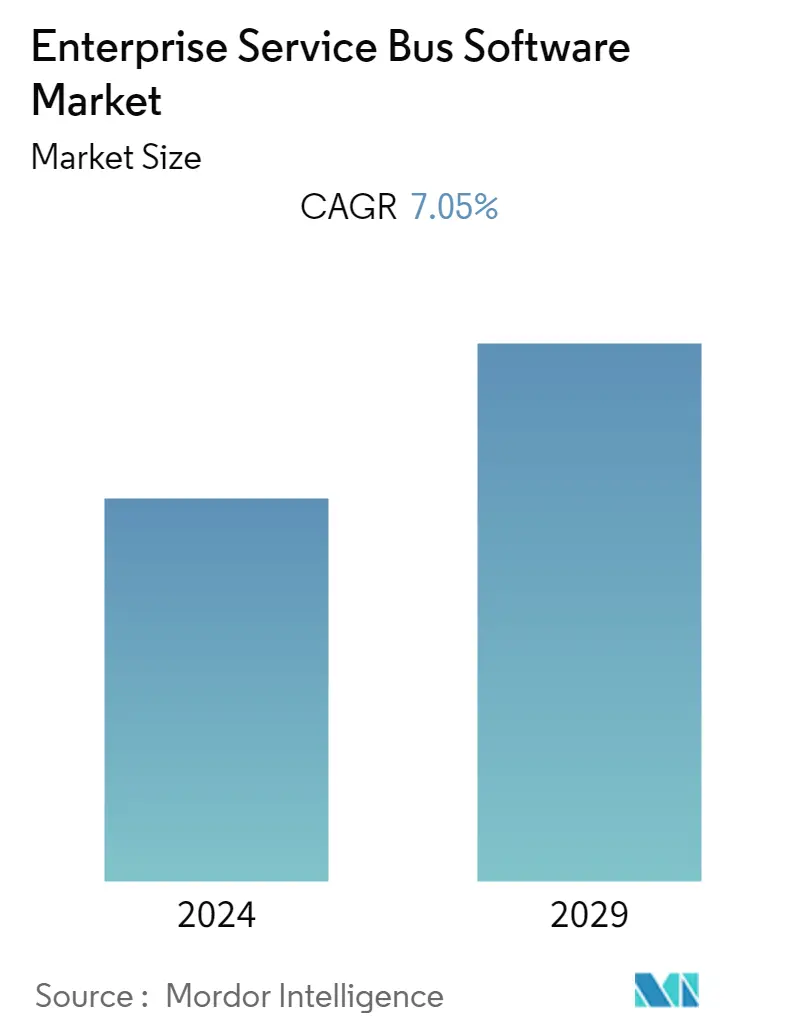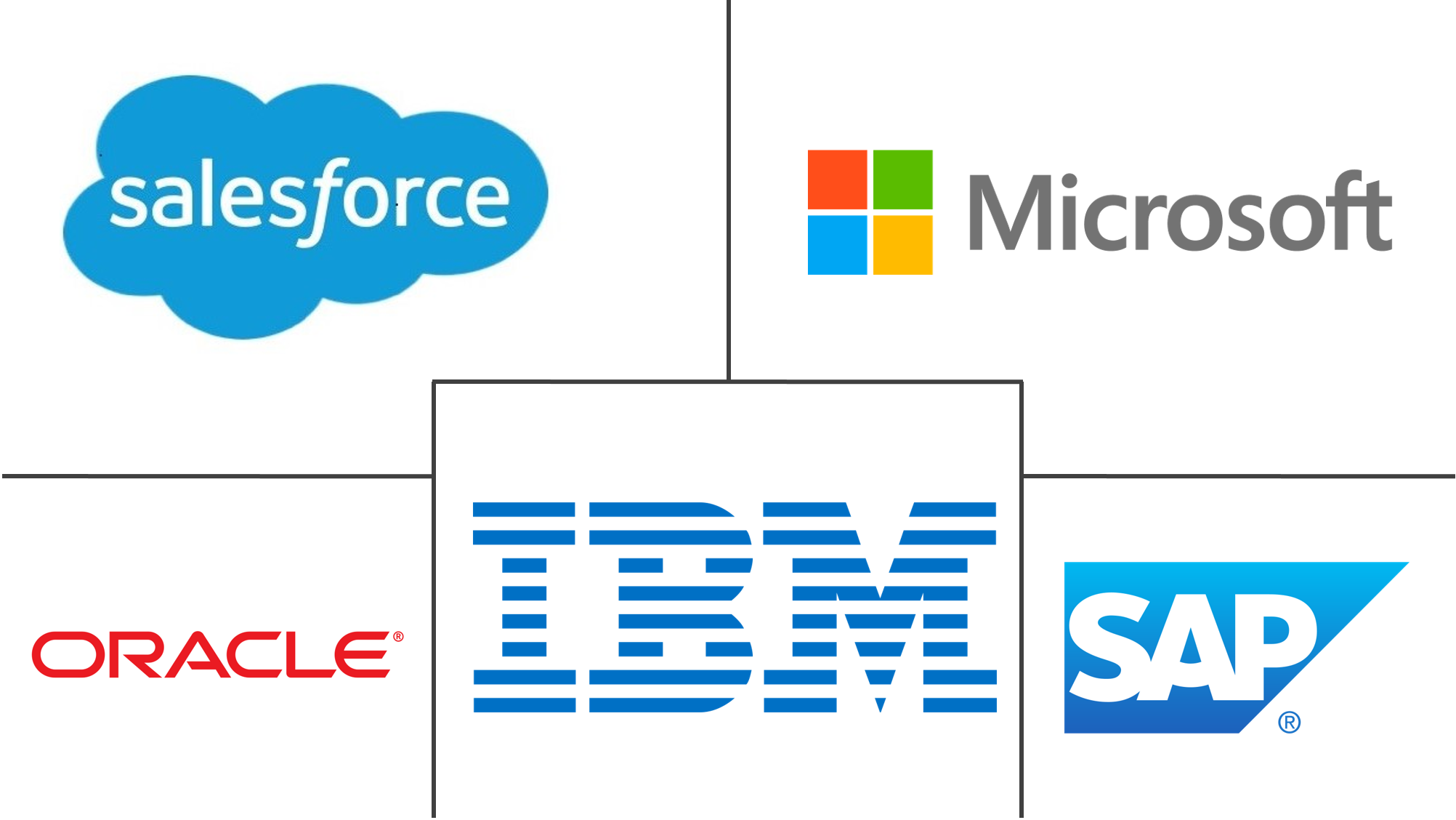Market Size of Enterprise Service Bus Software Industry

| Study Period | 2019 - 2029 |
| Base Year For Estimation | 2023 |
| CAGR | 7.05 % |
| Fastest Growing Market | Asia-Pacific |
| Largest Market | North America |
| Market Concentration | Low |
Major Players
*Disclaimer: Major Players sorted in no particular order |
Enterprise Service Bus Software Market Analysis
The Enterprise Service Bus Software Market is poised to register a CAGR of 7.05% during the forecast period. Due to the increasing demand for application integration across organizations, enterprise service buses (ESBs) witnessed a rise in their utilization across enterprises and organizations.
- The COVID-19 outbreak demonstrated the value of business intelligence, analytics, cloud computing, and mobile computing for ensuring that organizations run smoothly. After this, companies started using these services to improve their work architecture. This was the turning point for enterprise service bus software in the market.
- ESB architecture distributes information across enterprises quickly and ensures the smooth delivery of information, even when some networks or systems are offline occasionally, by eliminating the need to rewrite the application. Thus, most companies implement the ESB architecture as the backbone of their IT infrastructure.
- Furthermore, majorly driven by the adoption of cloud platforms that serve as a way to integrate various applications and can facilitate new and expanded channels as well as improve access to client data, allowing for better-tailored products and services, the IT and telecom industries are expected to mark a significant rise in the use of ESBs.
- Banks are also moving more of their data, processes, and infrastructure to the cloud to take advantage of cloud implementation, which makes it easier for enterprise applications to work together.For instance, the State Bank of India, for its 23,000 branches, chose Office 365, a cloud-powered productivity solution from Microsoft, to improve communication and collaboration among its workforce and transform it into a modern workplace.
- Older businesses that keep their data on paper will take some time to move to the cloud, which could sometimes affect how the business works. They will also have to change parts of the data at a time instead of all of it at once. Concerns about the high cost of installation are also a threat to the growth of the market.
Enterprise Service Bus Software Industry Segmentation
The enterprise service bus (ESB) is one of the best ways to connect applications and services so that end users only have to deal with a single, consistent, and reliable interface.It does this by offering crucial services for more complicated architectures. By connecting all of these programs through a communication bus, ESB combines applications, manages resources, and manipulates data. Moreover, it offers the framework required to develop tools for translation, routing, and other types of integration. Because the systems or networks are separated by the ESB, they can connect without being aware of or dependent on other systems on the bus.
The enterprise service bus software market is segmented by deployment (on the cloud and on-premise), end-user industry (IT and telecom, healthcare, and BFSI), and geography.
The market sizes and forecasts are provided in terms of value (USD million) for all the above segments.
| Deployment | |
| On Cloud | |
| On-premise |
| End-user Industry | |
| IT and Telecom | |
| Retail | |
| Healthcare | |
| BFSI | |
| Other End-user Industries (Government, Manufacturing, and Utilities) |
| Geography | |
| North America | |
| Europe | |
| Asia-Pacific | |
| Latin America | |
| Middle East & Africa |
Enterprise Service Bus Software Market Size Summary
The Enterprise Service Bus (ESB) Software Market is experiencing significant growth, driven by the increasing need for application integration across various sectors. The COVID-19 pandemic highlighted the importance of technologies such as business intelligence, analytics, and cloud computing, prompting organizations to adopt ESB architectures to enhance their IT infrastructure. These architectures facilitate seamless information distribution across enterprises, even during network disruptions, by eliminating the need for extensive application rewrites. The IT and telecom industries, in particular, are witnessing a surge in ESB adoption due to the growing reliance on cloud platforms for integrating applications and improving client data access. This trend is also evident in the banking sector, where institutions are migrating to cloud-based solutions to streamline operations and enhance collaboration.
The proliferation of IoT-connected devices is further propelling the demand for ESB software, as the integration of these devices and data becomes increasingly complex. Organizations are investing in ESB solutions to manage communication between diverse devices and networks effectively. The Asia-Pacific region is expected to lead in market growth, driven by the region's focus on IoT platforms and the migration of complex workloads to cloud solutions. Major companies in the region are leveraging ESBs to enhance organizational flexibility and responsiveness to market changes. The market is characterized by intense competition and rapid innovation, with key players like Oracle, Microsoft, IBM, SAP, and MuleSoft driving advancements. Collaborations, such as those between Red Hat and General Motors, are further enhancing the capabilities of ESB software, supporting the integration of advanced technologies in various industries.
Enterprise Service Bus Software Market Size - Table of Contents
-
1. MARKET DYNAMICS
-
1.1 Market Overview
-
1.2 Market Drivers
-
1.2.1 Growing Adoption of Cloud-based Solutions
-
1.2.2 Rising Development of IoT Projects
-
-
1.3 Market Restraints
-
1.3.1 High Installation Cost to Challenge the Market Growth
-
-
1.4 Industry Attractiveness - Porter's Five Forces Analysis
-
1.4.1 Bargaining Power of Suppliers
-
1.4.2 Bargaining Power of Buyers/Consumers
-
1.4.3 Threat of New Entrants
-
1.4.4 Threat of Substitute Products
-
1.4.5 Intensity of Competitive Rivalry
-
-
-
2. MARKET SEGMENTATION
-
2.1 Deployment
-
2.1.1 On Cloud
-
2.1.2 On-premise
-
-
2.2 End-user Industry
-
2.2.1 IT and Telecom
-
2.2.2 Retail
-
2.2.3 Healthcare
-
2.2.4 BFSI
-
2.2.5 Other End-user Industries (Government, Manufacturing, and Utilities)
-
-
2.3 Geography
-
2.3.1 North America
-
2.3.2 Europe
-
2.3.3 Asia-Pacific
-
2.3.4 Latin America
-
2.3.5 Middle East & Africa
-
-
Enterprise Service Bus Software Market Size FAQs
What is the current Enterprise Service Bus Software Market size?
The Enterprise Service Bus Software Market is projected to register a CAGR of 7.05% during the forecast period (2024-2029)
Who are the key players in Enterprise Service Bus Software Market?
Oracle Corporation, Microsoft Corporation, IBM Corporation, SAP SE and Salesforce.com Inc. (MuleSoft Inc. ) are the major companies operating in the Enterprise Service Bus Software Market.

